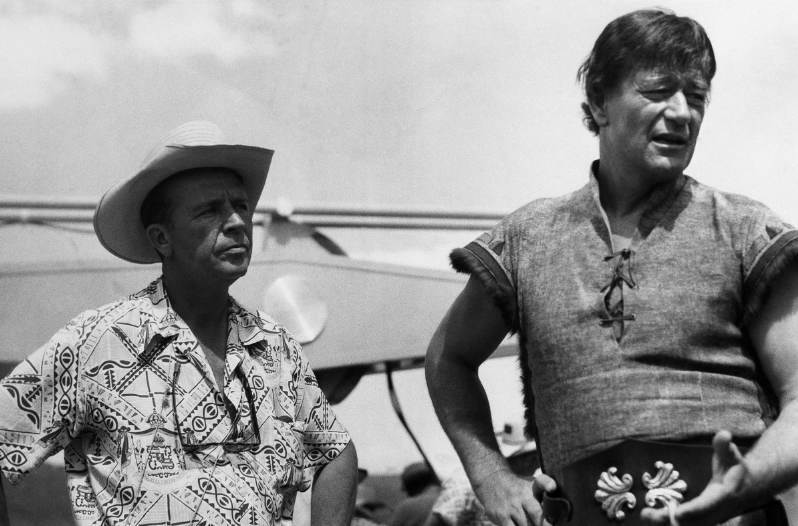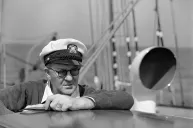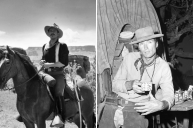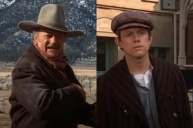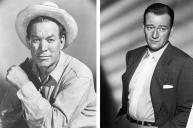John Wayne's incredible career is filled with countless classic hit films and numerous leading ladies like the great Katharine Hepburn and Maureen O'Hara. When director Raoul Walsh first suggested a young John Wayne be the star in his 1930 film The Big Trail, he probably had no idea he was launching the career of one of the most beloved artists of all time.
Wayne frequently collaborated with the great director John Ford on westerns like Stagecoach (1939), The Long Voyage Home (1940), Fort Apache (1948), Red River (1948), She Wore a Yellow Ribbon (1949), The Quiet Man (1952), The Searchers (1956), and The Man Who Shot Liberty Valance (1962). But there's one film from his career that is widely believed to be directly tied to the reason he passed away in 1979 — The Conqueror.
In one of the worst miscasting decisions of all time, The Duke, an American icon and future Oscar winner, starred in the 1956 film as the Mongol Emperor Genghis Khan. That's right. In case you blacked out the memory of this film happening, it indeed happened. He starred opposite Susan Hayward who played the captive princess and love interest, Bortai, in this Dick Powell directed film.
Not only was the casting confusing, but things really took a turn when Hollywood decided that the perfect place to film their Howard Hughes-funded box office draw was in St. George, Utah.
At the time, there wasn't anything particularly alarming about this small town aside from the fact that it was around a hundred miles away from an atomic bomb test site in Nevada. The federal government told filmmakers that it was safe for filming so the cast and crew poured into the town filling every hotel and motel. They even cast locals as extras. They had no idea that the nearby Snow Canyon, which was used as one of the main filming locations, had become a radioactive hot spot. Eleven atomic bombs had been tested the year before filming, blowing contaminated air downwind to Utah.
Hughes even had some of the dirt from the area shipped to Los Angeles, California to make reshoots look realistic. That definitely didn't help anything.
Years later, as cast and crew members started getting cancer, the connection was made back to The Conqueror set. Powell died in 1963 from lymphoma. Hayward passed away in 1975 from brain cancer. Wayne passed way in 1979 from stomach cancer, though he theorized it was due to his long term smoking habits. Pedro Armendáriz took his own life when he was diagnosed with terminal kidney cancer. Lee Van Cleef passed away from throat cancer. Out of a cast and crew of 220, 91 had contracted cancer, and 46 had passed away as a result of lung cancer, throat cancer and other forms of cancer. That is a stunning statistic.
Dr. Robert C. Pendleton, director of radiological health at the University of Utah, told People in 1980 that he feared the radiation in the area was directly tied to all of the cancer deaths from those on the film set.
"With these numbers, this case could qualify as an epidemic," Pendleton said. "The connection between fallout radiation and cancer in individual cases has been practically impossible to prove conclusively. But in a group this size you'd expect only 30-some cancers to develop. With 91, I think the tie-in to their exposure on the set of The Conqueror would hold up even in a court of law."
Read more: Wyatt Earp: The Wild West Icon Served as a Consultant on Early Western Films
In addition to those working on the film itself, family members who came to visit the set also had cancer scares. Michael and Patrick Wayne both visited their father and had skin cancer and a benign breast tumor removed, respectively. Hayward's son had a benign tumor removed from his mouth, though he believes it could be from his smoking habits.
In his later years, Hughes felt "guilty as hell" that his production company subjected all of those people to the toxic ground in Utah. He apparently spent $12 million purchasing every copy of The Conqueror and watched it constantly in his final days before he passed away in 1976.
Despite the catastrophe that was The Conqueror, it didn't really have any negative effects on Wayne's career. He went on to star in the Howard Hawks directed films Rio Bravo and El Dorado, as well as The Green Berets (the only film made during the Vietnam War that supported the war), The Alamo, The Cowboys and his last film, The Shootist. Most importantly, he played the starring role of Rooster Cogburn in True Grit which earned him his only Academy Award for Best Actor, though he had previously received his first nomination in 1949 for Sands of Iwo Jima.
Wayne passed away at the UCLA Medical Center in Los Angeles. You can visit the Duke's birthplace in Winterset, Iowa to learn all about the beloved actor and his upbringing (when his name was still Marion Morrison) before he moved to Glendale, California. We'll never know for sure if the tragic motion picture The Conqueror killed John Wayne, but we know that it was certainly one of the biggest mistakes in the history of Hollywood.
Now Watch: Clint Eastwood: Meet the American Icon's 8 Children
This article was originally published on September 18, 2020.
